Cozy up with a piping hot bowl of hearty Miso Soup with Yuzu Kosho. Japanese citrus pepper paste adds a refreshing, spicy kick and pairs wonderfully with this soup packed with pork belly and vegetables. {Vegan adaptable}

Soups are ideal for serving nutrient-dense foods that nourish our bodies. That is why the Japanese drink a warm bowl of miso soup almost every single day. There are many versions of miso soup one can make at home, but this Miso Soup with Yuzu Kosho is everything my family and I desire for dinner at home. Simmered in a dashi broth, it’s deliciously layered with pork belly, shiitake mushrooms, sweet cabbage, carrots, leek, and tofu, and lightly spiced with a very special condiment – yuzu kosho.
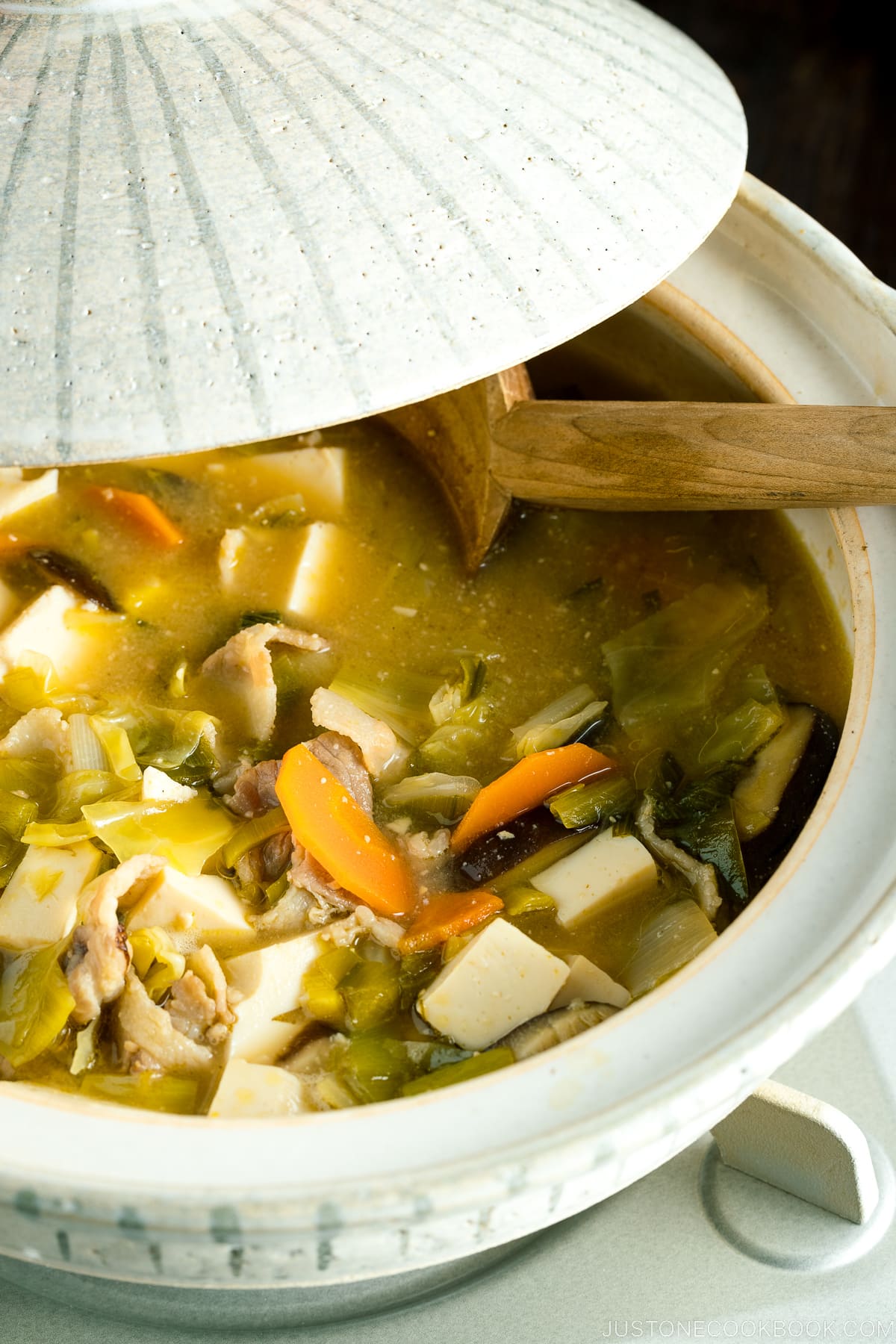
Miso Soup with Yuzu Kosho
I remember vividly when I first tried miso soup that was flavored with yuzu kosho. It was at a breakfast setting at a Japanese ryokan in Kurokawa Onsen, Kyushu (read here). The lady who served our hot breakfast told me to add in yuzu kosho to the miso soup. I thought I’ve heard her wrong and found myself repeating after her “yuzu kosho in miso soup?”, but only with a highly dubious face. She smiled and gave me some reaffirmation nods.
Now, while I enjoy using yuzu kosho to season meat or to flavor yakitori and other dishes, I’ve never heard of seasoning miso soup with yuzu kosho. Curiously, I took the lady’s advice and gave it a try. I first drank the miso soup as it was, and it was delicious, then I added a tiny bit of yuzu kosho to my soup and drank it again. Wow…I was blown away instantly!
Watching my deep satisfaction, Mr. JOC followed suit and added some yuzu kosho into his miso soup. Needless to say, he too was taken by how insanely delicious this little pepper paste did to the soup. We both happily drank up our soup and asked for okawari (second serving). The lady was so happy to see how amazed we were and she kept asking if we want another okawari.
Citrusy, slightly spicy, slightly salty but incredibly aromatic, who would have thought this condiment can add so much more punch to the everyday soup that I’ve been drinking all my life. I would never forget my first taste. Since we returned home to the States, we’ve been enjoying our miso soup with yuzu kosho frequently and we’ve been telling our friends and family about this little new discovery, and I would love for you to try it too.
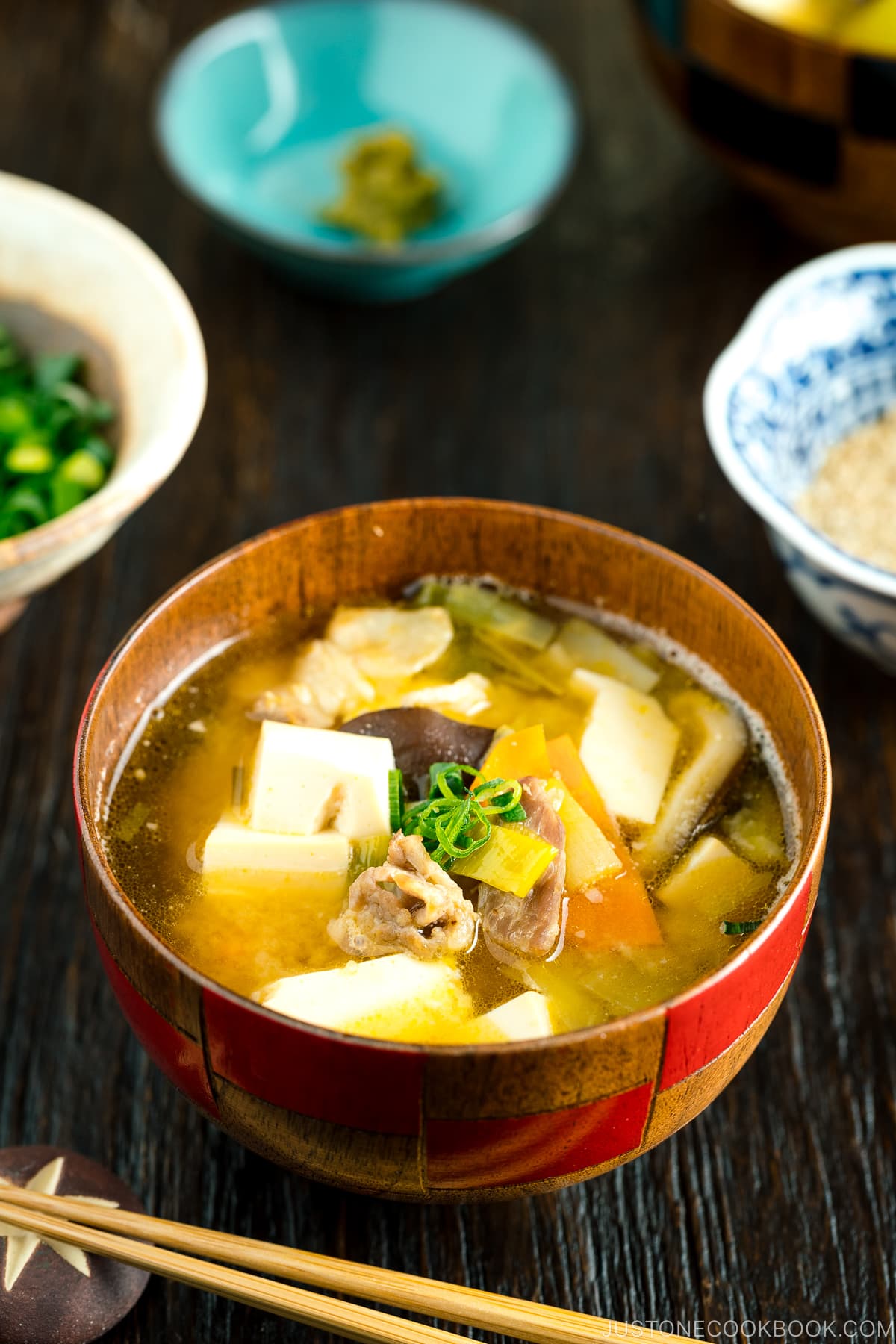
What’s Yuzu Kosho?
Yuzu kosho is still a relatively unknown condiment to most outside of Japan, but when I was recently Google Trends searching Yuzu Kosho, I was surprised to see it actually has a higher result than the direct translation of “yuzu pepper”. I think many Japanese restaurants are using Yuzu Kosho on their menus these days, and many customers are probably searching it on their phone while trying to decide what to order.
So what is yuzu kosho? Yuzu is a winter citrus that’s used in Japanese cooking. It has a flavor somewhere between a lemon, mandarin orange, and grapefruit! It looks like this, and I have used this citrus to make Yuzu Sorbet. Yuzu kosho is simply a paste made from chili peppers, yuzu peel (when it’s still green), and salt. It is then allowed to ferment to bring out the flavors even stronger.

The best yuzu kosho is the one pictured above. It comes in a jar and costs about $8-9. You can find it in the spice aisle (where they carry wasabi, karashi mustard, shichimi togarashi, etc) at Japanese grocery stores. You can also find a different brands on Amazon.
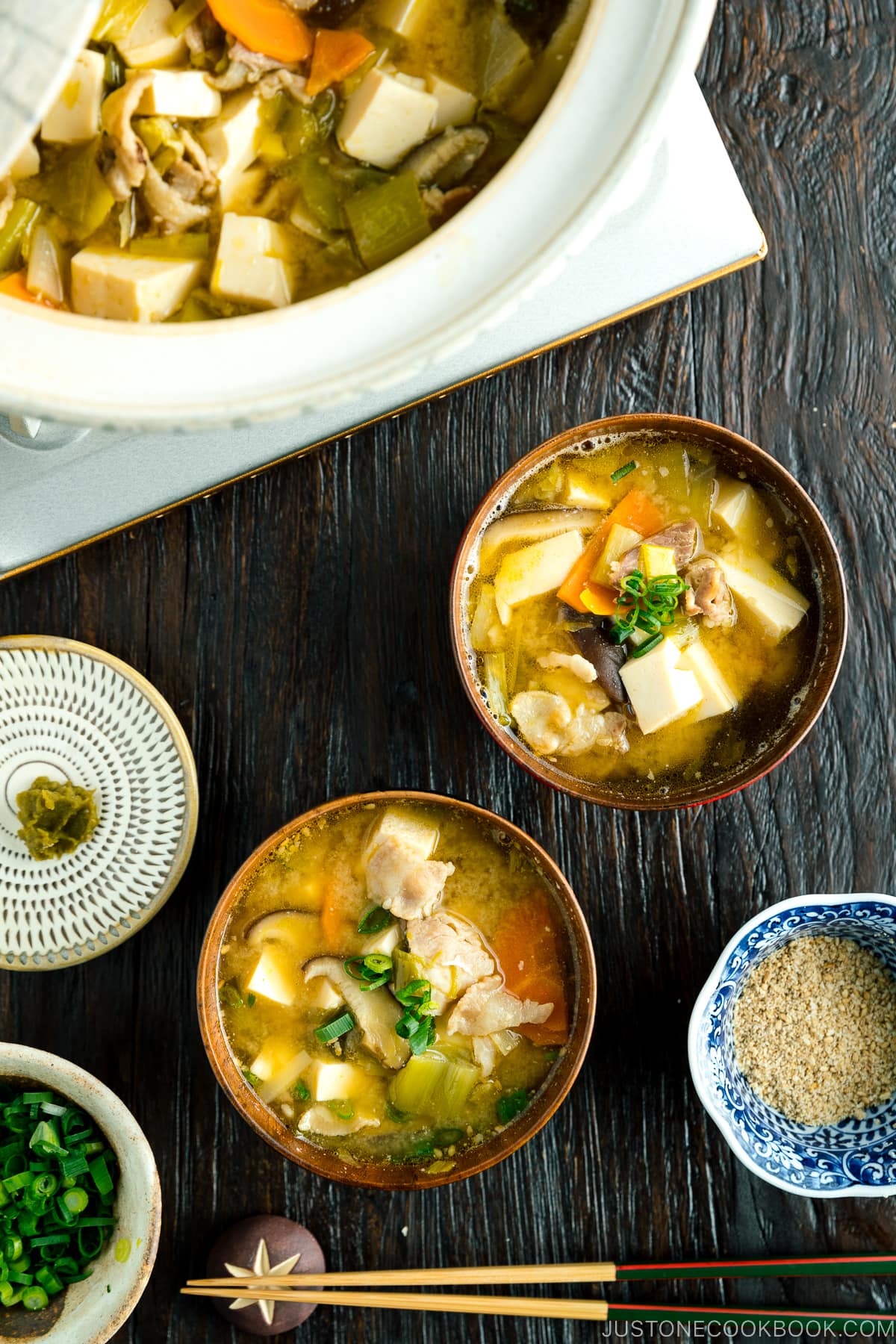
Substitutions and Variations
Miso soup is all about customization. If you couldn’t find thinly sliced pork belly, that’s okay. You can leave it out. Just know that pork belly is not bacon; it’s the same cut as bacon but it is fresh/raw and not cured like bacon. Not a fan of mushrooms or tofu? That’s okay too.
You can make a vegetarian/vegan version with kombu dashi (just leave out katsuobushi) and add in lots of vegetables. You can add pretty much any vegetable in your miso soup, even though they may not be the typical Japanese options. If you only have kale in your hands, of course, you can throw in some kale in your miso soup. Just because we don’t use kale in Japanese food, it doesn’t mean we can’t have miso soup with kale.
If you’re not sure with your selection of vegetables, leave a comment below and I’ll see if it’s a good match.
Whether you’re making regular or vegetarian miso soup, you must use dashi for the soup broth. Do not substitute with chicken broth or water because dashi is the only ingredient that makes miso soup taste authentically Japanese.
If you love miso soup, I hope I’ve convinced you to add a jar of yuzu kosho to your pantry so you can have your miso soup with this amazing pepper paste. The spicy, citrusy and aromatic flavors of the condiment really do the trick to elevate the bowl of soup and everything just taste a whole lot more delicious.

Wish to learn more about Japanese cooking? Sign up for our free newsletter to receive cooking tips & recipe updates! And stay in touch with me on Facebook, Pinterest, YouTube, and Instagram.
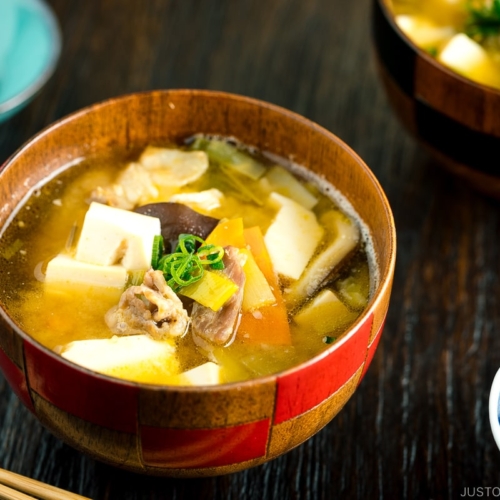
Miso Soup with Yuzu Kosho
Video
Ingredients
- ¼ lb sliced pork belly (4 oz; skip for vegan/vegetarian)
- 1 leek
- 2 leaves green cabbage
- 4 pieces shiitake mushrooms
- 2.5 oz carrot (1½ inches, 3.8 cm)
- 2 green onions/scallions
- 1 Tbsp toasted sesame oil
- 1 Tbsp sake
- 4 Tbsp miso
- 14 oz soft/silken tofu (kinugoshi dofu) (1 block, cut into cubes)
- yuzu kosho (Japanese citrus chili paste) (to taste)
- 2 Tbsp toasted white sesame seeds
For the Dashi
- 4 cups water (for standard Awase Dashi; you can also use a dashi packet or powder; skip the katsuobushi for Vegan Dashi)
- 1 piece kombu (dried kelp) (3 x 4 inches, 7.5 x 10 cm per piece)
- 3 cups katsuobushi (dried bonito flakes) (skip for vegan/vegetarian)
Instructions
- Gather all the ingredients.

To Start the Dashi
- In a measuring cup (or a large pot), add 4 cups water and 1 piece kombu (dried kelp). Let it steep overnight (if possible) or as soon as you start preparing this dish. This is kombu dashi or Vegan Dashi. Tip: Alternatively, you can make dashi with dashi powder or a dashi packet.

To Prepare the Ingredients
- Meanwhile, prepare the other ingredients. Cut ¼ lb sliced pork belly into 1-inch (2.5-cm) pieces.

- Cut 1 leek in half lengthwise, and then cut the halves into 1-inch (2.5-cm) pieces widthwise. Rinse under cold water to make sure there is no dirt in the leek layers.

- Cut 2 leaves green cabbage into small pieces.

- Remove the stems of 4 pieces shiitake mushrooms and slice the caps thinly.

- Cut 2.5 oz carrot in half lengthwise and slice thinly. Cut 2 green onions/scallions thinly.

To Finish the Dashi
- Transfer the vegan kombu dashi to a soup pot or donabe. Slowly bring the kombu dashi to a boil over medium-low heat. When the water is almost boiling, remove the kombu to avoid sliminess. If you are vegan/vegetarian, skip the next two steps.

- Add 3 cups katsuobushi (dried bonito flakes) and cook for 15 seconds. Then, turn off the heat and let the katsuobushi steep in the pot for 15 minutes.

To Cook the Miso Soup
- Meanwhile, in a separate large pot (or donabe), heat 1 Tbsp toasted sesame oil over medium heat. Once the pot is hot, add the pork belly and stir to cook.

- Once the pork belly is 80% cooked through, add 1 Tbsp sake and stir to combine. Then, add the chopped leeks.

- Once the leeks are wilted, add the rest of the vegetables and mushrooms. Stir to coat with the oil. Using a fine-mesh strainer, strain the dashi into the pot (or add the dashi you made with dashi powder or a dashi packet).

- Bring the soup mixture to a boil, skimming the foam and scum from the surface while cooking. Turn off the heat. Add half of the 4 Tbsp miso first, and then gradually add in more as you taste the soup. Each brand and type of miso tastes different and the sodium level varies, so you want to taste the soup before adding more miso.

- To the soup, add 14 oz soft/silken tofu (kinugoshi dofu), cut into cubes. Turn on the heat to continue to simmer until the tofu is warm (tofu is edible chilled, so you don’t have to worry about “cooking” it). Do not let the miso soup boil. It should take no more than 3–4 minutes to warm the tofu. The soup is now ready.

To Serve
- Before serving, scoop out a small portion of yuzu kosho (Japanese citrus chili paste) from the jar and place it on a small plate. Grind 2 Tbsp toasted white sesame seeds and put it in a small bowl. Serve them alongside the soup pot or donabe. After you ladle the soup into individual serving bowls, add a pinch of Yuzu Kosho, sprinkle some sesame seeds, stir in, and enjoy!

To Store
- You can keep the leftovers in an airtight container and store in the refrigerator for up to 3 days and in the freezer for 2 weeks.
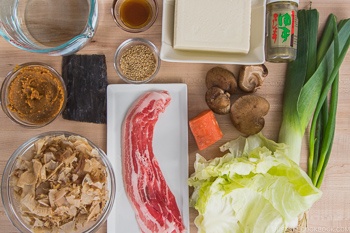
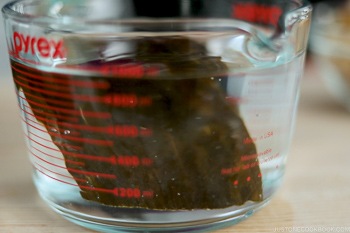
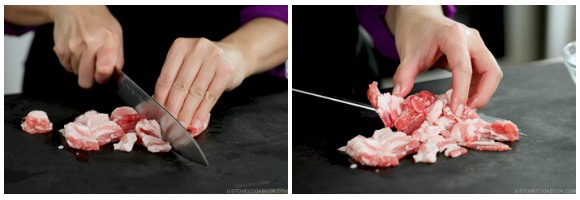


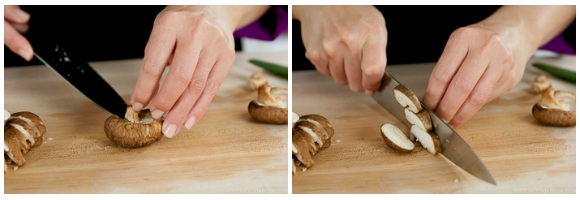


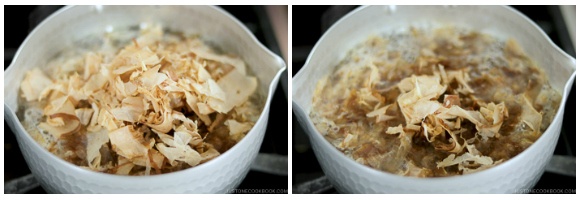
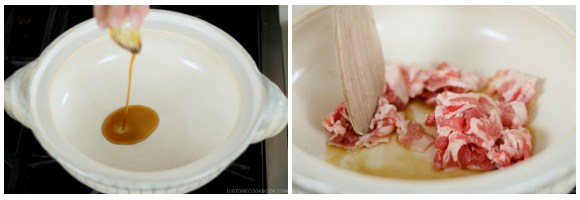
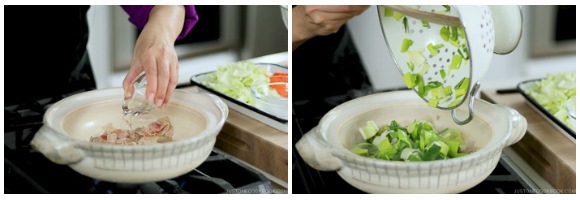


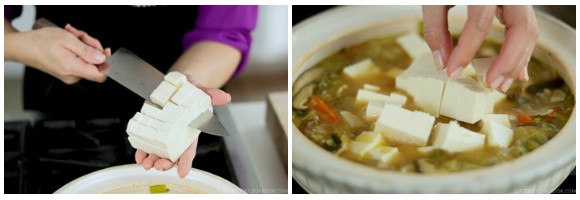











Ah! I love Yuzu Kosho paste. I will be making this version of miso immediately for my dinner! I make delicious fresh popcorn with it by mixing the paste with a little mild oil.
Hi Rose! Thank you for reading Nami’s post and trying her recipe!
Yuzu Kosho-flavored popcorn sounds delicious as well!🤩
Hi! How much of this soup is one serving? Approximately how many ounces or cups should a serving be? I fear that I eat too large of a portion 😳.
Hi JoAnna! Thank you very much for reading Nami’s post!
In Japan, usually, one serving is 1~1.5 cups. We hope this helps!
Because of your tip about adding Yuzu kosho to miso soup, now I only have miso soup with it and sesame seeds 😁 Thank you Nami. It’s been super helpful since I moved to Japan and found your blog. Nowadays, I feel confident to say that I’m able to cook Japanese home food. Understanding the seasonings and how to use them make my life lighter and easier here. Thank you again! ☺️ Keep yourselves safe and updating us about Miso 🐶 please.
Hi Lilian,
Thank you so much for trying this recipe and for your kind feedback. We’re so glad to hear you enjoyed the Yuzu Kosho!
Thank you for sharing your story with us!
you make every dish look so simple to create ! And I have made some. This one is on my list eext.. i am going to the Japanese market in Beverton Oregon today to get a great ceramic pot and morter and pestel. This website is the best cooking tool ever. Thank you Merideth
Hi Nami, this soup looks yummy. May I know if I substitute pork with beef would it taste as good?
Thanks!
Hi Cecilia! I’ve never made miso soup with beef before and beef in miso soup is quite rare. However, some people make it so sure, give it a try! Hope you enjoy!
Love love love this recipe! I couldn’t find yuzu but I added gochujang and some white pepper and it was really good. Even without spice, it’s yummy. The chopped green onions really make this. 🤤
Hi JoAnna! I’m so happy to hear that you enjoy this recipe! Thank you for your kind feedback!
[…] Yuzu Kosho (柚子胡椒) is a paste made from chili peppers, yuzu peel, and salt which is then allowed to be fermented. It’s a wonderful condiment that I highly recommend searching for when you visit a Japanese grocery store. I LOOOOVE to add a bit of this paste in my miso soup. […]
Ciao, amo molto zuppa di miso, però io uso dashi granulare. Mi puoi dire la proporzione da usare a persona? Grazie mille.
Hi Maria! Here it is: https://www.justonecookbook.com/how-to-make-dashi-3-ways/
For Dashi Powder:
2 cups water (420 ml)
1 tsp dashi powder (3 g)
You probably need 1/2 of the portion for one serving miso soup. 🙂
[…] Miso Soup with Yuzu Kosho […]